késleltetett adatok
Exclusive research: Trump could easily defeat Biden
The McLaughlin & Associates polling company conducted an exclusive survey in collaboration with the Századvég Foundation regarding the chances of the 2024 US presidential election. According to the poll’s findings, Donald Trump would defeat the incumbent president by a landslide – the Mandiner writes.

This February, researchers interviewed 1,600 citizens in the so-called battleground states, including 737 Republicans, who said they were likely voters. Battleground states are like swing constituencies in Hungary where the outcome of an entire presidential election can often depend on a few thousand votes, and therefore they receive above-average attention (for more information, see the end of this article).
What is clear from the polls is that the majority of Americans think that things are going in the wrong direction under Joe Biden’s presidency, and former president Donald Trump may have a good chance of defeating his current opponent – and while the overall image of his major party rival, Governor Ron DeSantis of Florida, may be slightly better than Trump’s, it is far from certain that this will translate into votes in 2024.
But let’s see the numbers!
They would wipe the floor with the Democrats and Biden
The first and most important question was: do voters feel America is moving in the right direction under President Biden?
Here the results were quite clear:
two-thirds of respondents, or 66 percent, thought things were going in the wrong direction,
with a higher proportion of those who were very dissatisfied (41 percent) than those who were only somewhat dissatisfied (26 percent).
Just 34 percent were optimistic, with only 9 percent claiming that things were going very well and 24 percent testifying that things were going only somewhat well (due to methodology and rounding, percentages do not always add up to 100).
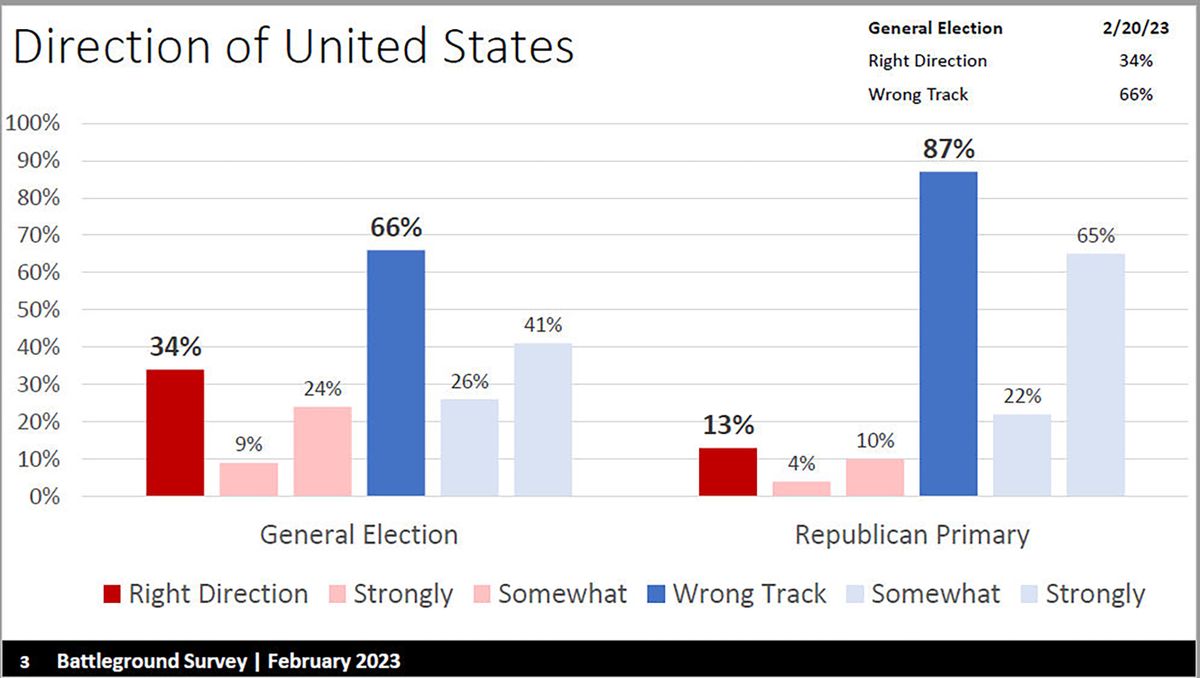
Republican-leaning respondents, of course, produced an even more damning assessment, with 87 percent of them saying things were bad (65 percent say strongly bad, 22 say somewhat bad) and 13 percent saying things were good (4 say very good, 10 say somewhat good).
Then came the question of party preference: which party would you vote for, and if so: definitely, probably or maybe?
The Republican lead here is well above the margin of error, with 48 percent of voters in favor of the GOP, compared to 43% for the Democrats.
In addition, Republican voters appear to be more determined, with a higher percentage of undecided voters than the Democrats (31 percent compared to 27 percent). The percentage of undecided voters was 10 percent.
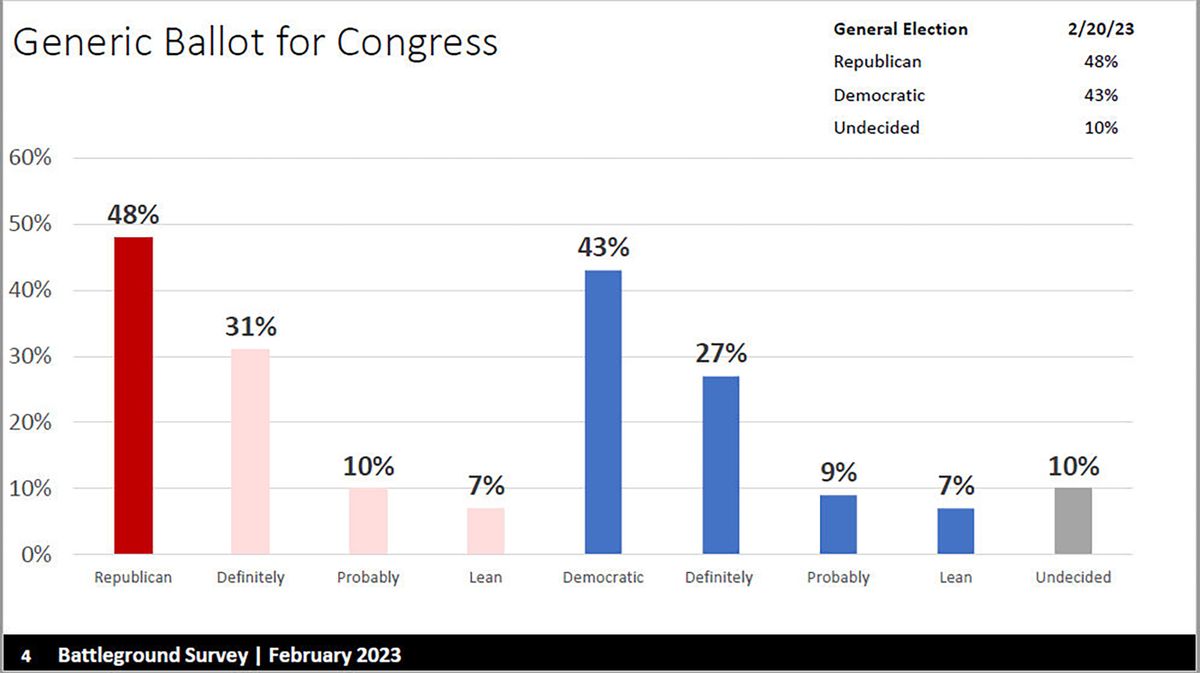
Then came questions addressing the image of certain prominent politicians. These were used to assess the image of Joe Biden, which proved to be less than favorable among the total cohort of respondents.
56 percent disapproved – this was the proportion of respondents who had an “unfavorable” image of Biden, with a majority of those who strongly disapproved (42 percent). 42 percent of the respondents had a favorable image of the President, the majority being not very enthusiastic. For 25 per cent, Biden only “somewhat” had a favorable image. 17 percent said they had a very favorable image of him and 2 percent declined to answer. Understandably, the disapproval rating was higher among Republicans, with a favorable-to-unfavorable ratio of 89-10, also with 2 percent not responding. In short, if Trump is said to be “divisive”, Biden is similarly so.
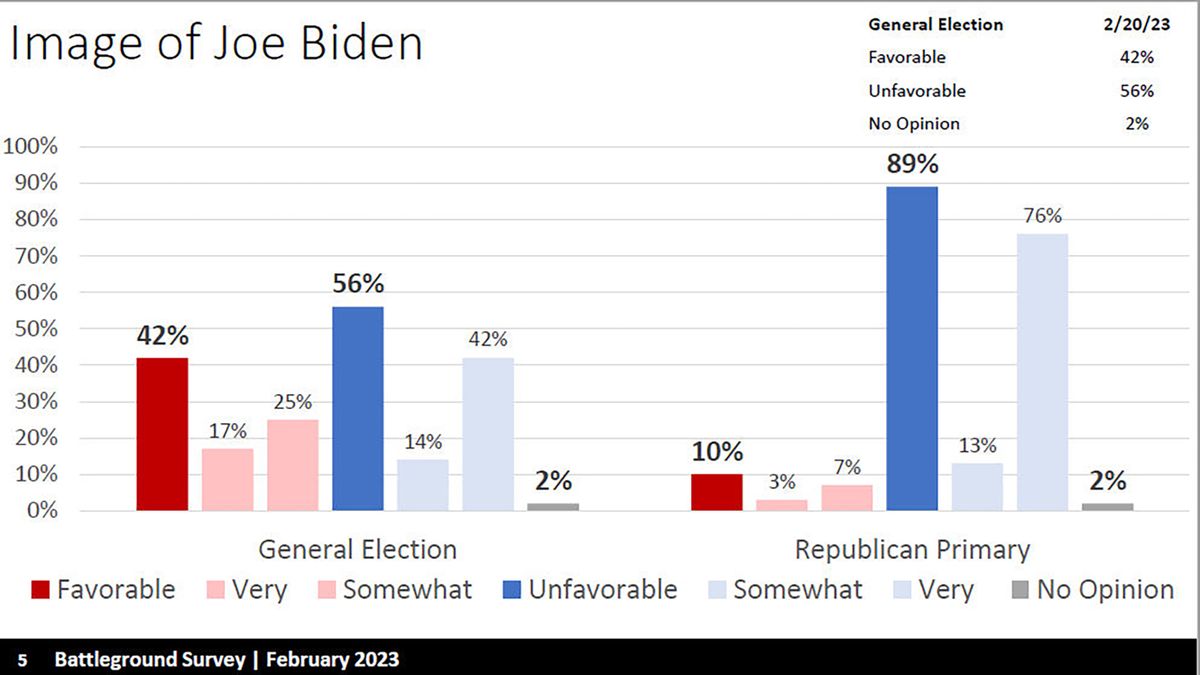
However, while for Democrats it was clear that the President would run again, the Republicans are somewhat more divided. In addition to former President Donald Trump, potential presidential candidates include Ron DeSantis, who has previously not held a similar position and is therefore less well-known. Both politicians have their own camps of supporters who reject the leader of the other camps – and this is visible from the figures as well.
As for Trump, his disapproval rating among all respondents is 57 percent, and 41 percent associate him with a positive image. Among Republicans, 70 percent have a favorable image of the former president, as opposed to 29 percent do not.

In contrast, DeSantis’ numbers are similar at first glance: 70 percent say he has a positive image, 14 percent say he does not, and more tellingly, 10 percent have no opinion of him, while another 6 percent admit they have never heard of DeSantis. A not very well-known person would probably find it difficult to mobilize the masses, although there is still time to build up name recognition.
In a further question, polling compares Trump’s and Biden’s election chances; unsurprisingly, the two candidates came out ahead in terms of party preference. That is:
48 percent would vote for Donald Trump, while only 43 percent would vote for Joe Biden.
The two camps seemed similar in terms of determination, but the share of undecided was slightly higher at 9 percent.
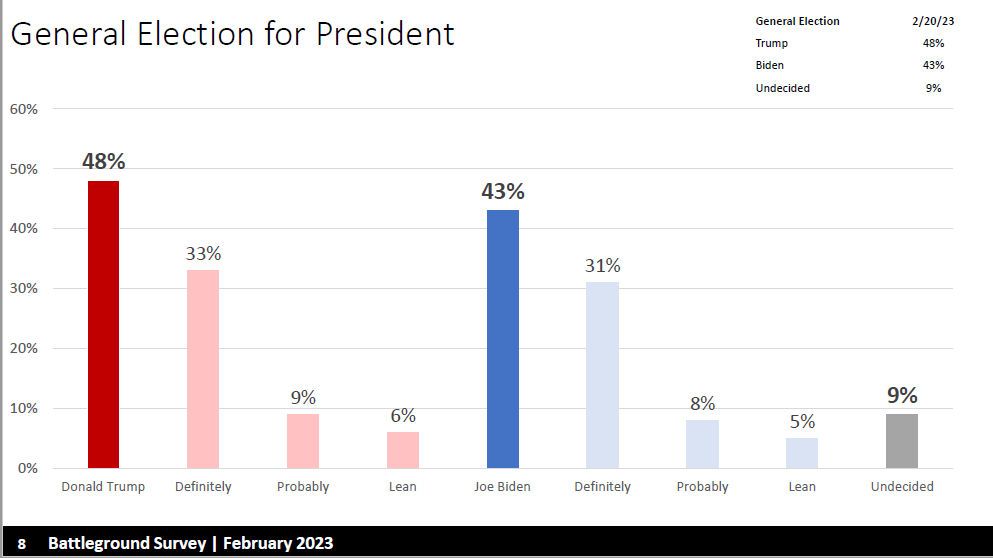
Of course, in order for either Trump or DeSantis to challenge the incumbent, he must first win the Republican primary, and if the present situation persists, the two men will be head to head with one another.
In this area, Trump is clearly in the lead, with 51 percent of the primary vote, or
an absolute majority would vote for Trump.
DeSantis, by comparison, would only get 41 percent of the vote (7 percent are undecided).
Proportionally, Trump supporters are also slightly more determined, with 35 percent reporting to de determined as opposed to 25 percent among Democrat voters.
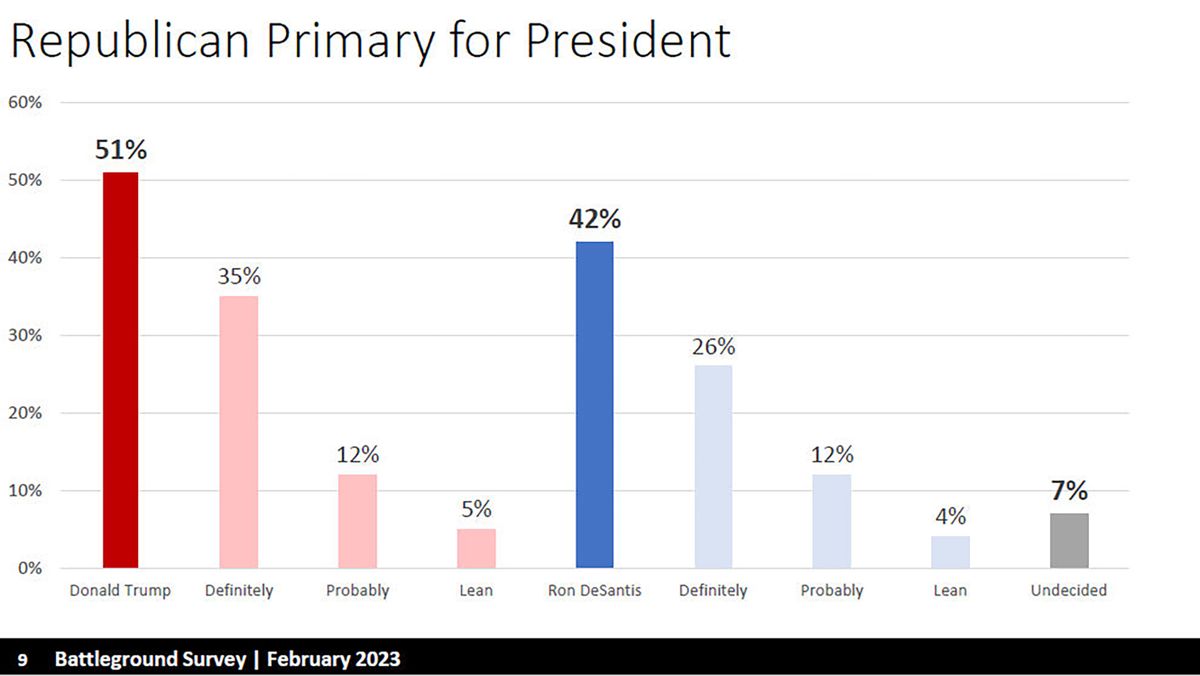
Polling experts asked the question more directly: who would be capable of defeating Joe Biden in 2024? Donald Trump or anyone else?
The percentages were even clearer: 57 percent said Trump would be the favorite,
the remaining 42 percent said someone else; this is a 14 percent difference, and somewhat in line with DeSantis’ relative obscurity vis-à-vis Trump.

The United States is heading backwards, not forwards
Then they went a little deeper into what the average American is feeling right now.
- For example, are you better or worse off since Biden became President?
The answer seems clear: rather worse. 48 percent of all respondents felt this way, 32 percent felt no change and 20 percent felt that they were better off than before. The proportion was even worse for Republicans: 79 percent worse off, 15 percent the same and just under 6 percent better off (i.e., 48 percent dissatisfied does not cover 48 percent Republicans: there may be a god number of dissatisfied undecideds and Democrats sympathizers).
- Or, what do you feel: has US been moving forward or backwards since 2020?
Respondents were clear: 65 percent think the US is going backwards, not forwards – only 35 percent think it is going forwards. The Republican result is crystal clear: 90 percent say backwards and just 11 percent say forwards.

Delving deeper into the minds of the average American voter, some interesting data also emerged:
42 percent of people feel anger, frustration and despair, 39 percent feel fear and worry, only 19 percent feel pride and patriotism.
The Republican result is not surprising: 53 percent are angry, frustrated and desperate, 38 percent are anxious and only 9 percent feel pride and patriotism.
The survey also went into more detail on the issue that is causing this immense anger and frustration:
both the average voter and the Republican voter cited inflation as the number one issue, at 19 and 22 percent, and ranked the economy as a strong performer, at 8 and 10 percent.
However, while 10 percent of Republicans felt that Joe Biden himself was a problem – and the third most serious problem – Trump’s person was 14th on the list of problems, with just 2 percent of all respondents.
It is also shown how little the issues on which the two major parties clash are social issues: at the very least, they were hardly mentioned by respondents themselves as the biggest issue: while migration is the third biggest issue for American with 6 percent (Republicans’ No. 2 issue with 11 percent), race and gender discrimination are less of a concern to Americans (4 percent of respondents), and abortion or media issues are less of an interest (1-1 percent).
The also tried to find the enemy of the United States, witch mixed answers but
the first place is not Russia at all, but China!
Indeed, 20 percent of all respondents and 28 percent of Republicans mentioned it.
Joe Biden has become the United States’ second worst enemy, at least according to 7 percent of all respondents and 14 percent of Republicans;
True, “Ourselves’ has achieved almost as much.
The list also includes China once more alongside Russia (“China/Russia”), bringing the total number of mentions from both categories to 5-5 percent;
Russia and Putin are only the fourth most dangerous enemy for all respondents, with 6 percent.
Then Joe Biden’s performance in individual “competitions” was also assessed separately. Here the President performed particularly woefully in all categories. Whether it was about reining in government spending, curbing illegal migration, fighting China, fighting corruption or fighting inflation, the satisfaction rate ranged between 24 percent to 32 percent, while the dissatisfaction rate was between 68 percent and 76 percent.
So, for every voter who was satisfied or rather satisfied with Biden on these issues, there were two or rather three dissatisfied voters. The result filtered to Republicans only is even more dismal, with 90-92 percent dissatisfied compared to 8-10 percent satisfied.
Biden: there’s trouble enough, results all the less
Everyone has weaknesses, some of them very many: one in five respondents mentioned the President’s advanced age (20 percent), not far behind (15 percent),
who say the president’s Joe Biden’s state of health and his mental fitness are his weakest points;
some saw it as just weak (5 percent), but there was still plenty of choice.
Republicans were even less forgiving, ranking mental health first (24 percent) and age second (12 percent), with another 6 percent saying the president is a “liar”.
Of course, Biden has achievements, but percentages show that they are not so clear: respondents could not really say that he had any outstanding results, 6 percent said that he was able to be the first to tackle the covid epidemic, 5 percent said that he beat Trump, and the rest is even less. However, it stands out.
26 percent say that the President has no real accomplishments. Of course, the Republicans have 44 percent.
Concerning the failures, 13 percent of the general respondents said migration, 12 percent said “everything”, 10 percent said inflation, 8 said his economic point of view, and 3 even blamed him for the withdrawal from Afghanistan (18 percent don’t know). Republicans are tougher here too, with 23 percent, for example, saying “everything’ is a failure of the president.
By the way, 53 percent of all respondents and 82 percent of Republicans consider Biden corrupt.
Researchers also took another spin on the president’s weaknesses, revealing that the overwhelming majority of respondents (78-76 percent) cited inflation, high prices, open borders and migration, the President’s health and mental health, and 72-70 percent said he lies about the state of the economy, his family is in conducting business with China, and he is simply a “weak leader” who has been a member of the Washington elite his whole life. Two-thirds of respondents (67-65 percent) say the president has colluded with the extremists or has never earned a dollar doing a decent job. The Republican data is similar – only more devastating.
As for the main issues, 90 percent of respondents agreed that “American should belong to the American people, not to Washington bureaucrats”; 87 percent said they want major change but they also expect a budget ceiling, a “purge of the US from Chinese communist influence” and 78 percent would end war spending. But three-quarters of respondents said
America belongs to the American people, not the illegal immigrants.
and 69 percent say it’s time to sweep the radical left out of Washington.
And 68 percent said
It is enough. We can’t afford Joe Biden’s inflation ever again.
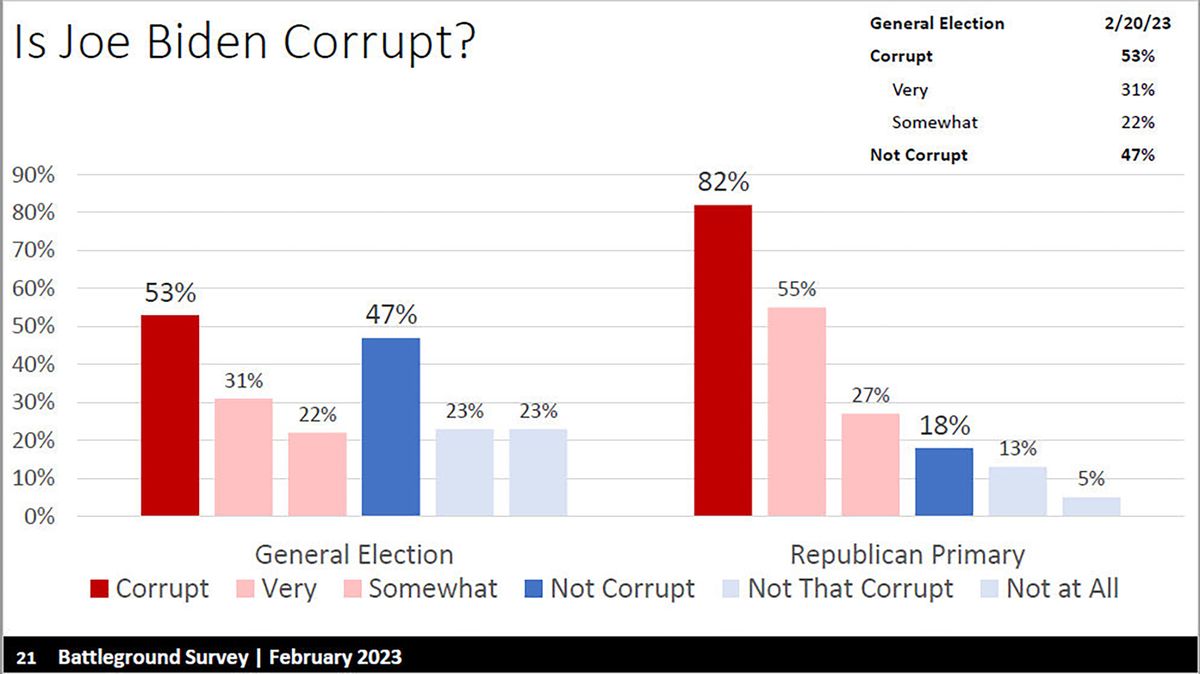
Trump, change and peace
Of course, whether Trump would bring the desired big change is a more divisive question: 57 percent say yes (89 percent for Republicans). Three quarters of those polled, by the way, see DeSantis as similar to Trump.
It is also interesting to note that Republicans are more afraid of the Russian-Ukrainian war (79) than the average voter (74), while the same majority (77 and 71 percent) say that
America should promote peace, and only 28 percent and 23 percent say the conflict should continue until Putin is defeated.
More people are worried about the impact of the war on the economy (83 percent of all, 89 percent of Republicans).
Finally, the staff of the two institutes also sought to gauge views on abortion, although we saw that this was more a subject for politicians to debate.
However,
Republicans appear to be more pro-life (65) than the average (47),
although those in favor of a complete ban on abortion are still in the minority (11 percent instead of 16 percent), and the reverse is true for full liberalization (20 percent and 8 percent); although they differ in degree, 35 percent of voters in the Republican primaries believe that abortion should only be legal in cases of saving the life of the mother, rape or incest.
Battleground States in 2020
According to official results, roughly 81 million people voted for Democrat Joe Biden and 74 million for Republican Donald Trump in the 2020 presidential election. However, since it is not individual votes that count, but actually electoral votes per Member State, all electors in each Member State must vote for the winning candidate in that Member State (so in effect, Member States elect their President on the basis of local majorities). This is the dominant "winner-take-all" system in the Anglo-Saxon world (with no list and no compensation). Member States are represented in the Electoral College on a proportional basis. Biden thus received 306 electoral votes in 2020, while Trump received 232. If we look at the states, however, we see that both candidates won in 25 states, with Biden also winning the capital district (Washington, D.C.). However, Biden won on average in the more populous states.
How many more votes a presidential candidate received and how many more votes he won are two separate numbers, due to local specifics. If we look not at how many more votes Biden got, but at how many votes the election came down to, we get a much smaller number: a few tens of thousands of votes per swing state.
The main swing states in this respect were Arizona, Georgia, Michigan, Pennsylvania and Wisconsin, which Trump won in 2016. The latter three were previously the bricks in the Democratic "blue wall" and it was a surprise that Trump won them then. In 2020, in any case, Biden won Georgia by 11,779 votes (0.24%); Arizona by 10,457 votes (0.31%); Wisconsin by 20,682 votes (0.63%); Pennsylvania by 80,555 votes (1. 16%); Nevada with 33,596 votes (2.39%); and finally, Michigan with 154,188 votes (2.78%). So in 2020, the closest races within 1 per cent were in Wisconsin, Georgia and Arizona, with a total of 42,918 votes.
Please find attached the detailed results of the survey:
A cikk magyar nyelven itt olvasható:

Portfóliónk minőségi tartalmat jelent minden olvasó számára. Egyedülálló elérést, országos lefedettséget és változatos megjelenési lehetőséget biztosít. Folyamatosan keressük az új irányokat és fejlődési lehetőségeket. Ez jövőnk záloga.

















